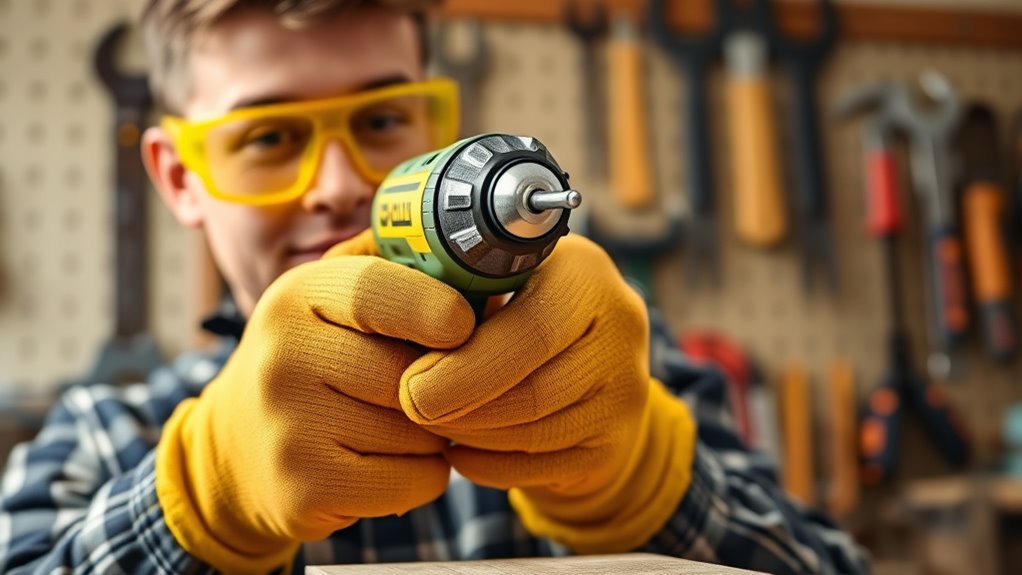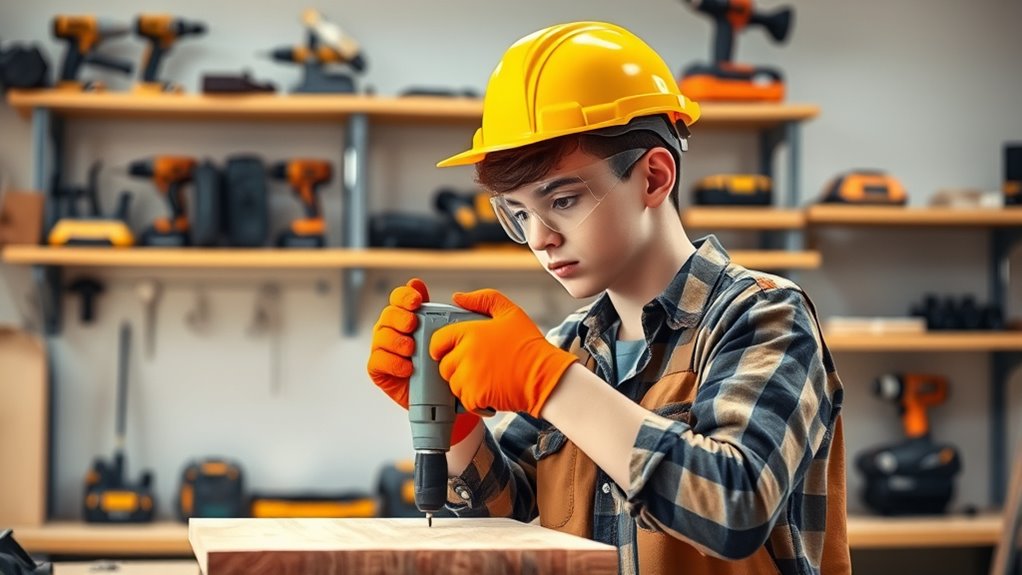To use power tools safely, always wear the right PPE like safety glasses, hearing protection, and gloves. Regularly inspect your tools for damage, keep blades sharp, and clean them after use. Handle materials securely with clamps, and stay focused to avoid accidents. Follow the manufacturer’s instructions and never bypass safety features. Keeping safety in mind boosts your confidence and project success—continue to explore these tips for a safer approach to power tool use.
Key Takeaways
- Always wear appropriate PPE such as safety glasses, hearing protection, gloves, and masks before operating power tools.
- Inspect tools for damage, keep blades sharp, and perform regular maintenance to ensure safe operation.
- Clear your workspace, secure materials with clamps, and familiarize yourself with safety features and emergency shut-offs.
- Follow proper handling procedures, avoid bypassing safety guards, and read user manuals thoroughly before use.
- Stay attentive, perform routine safety checks, and prioritize safety at every step to prevent accidents and injuries.

Power tools can make your projects easier and more efficient, but they also pose safety risks if not handled properly. As a beginner, your first priority should be protecting yourself with the right personal protective equipment. Always wear safety glasses or goggles to shield your eyes from flying debris, sparks, or dust. Hearing protection, like earplugs or earmuffs, is essential when working with loud tools to prevent hearing damage. Gloves can help protect your hands from splinters or minor cuts, but be cautious—they shouldn’t interfere with your grip or control, especially around rotating parts. A dust mask or respirator is indispensable when cutting or sanding materials that produce fine dust, helping you avoid inhaling harmful particles.
Always wear safety gear and inspect your tools to stay safe during DIY projects
Beyond gear, understanding power tool maintenance is essential for your safety and the longevity of your equipment. Regularly inspecting your tools before use can prevent mishaps caused by damaged cords, loose parts, or dull blades. Keep blades, bits, and attachments sharp; dull tools require more force and can slip, increasing your risk of injury. Cleaning your tools after each use removes dust, debris, and buildup that could affect their performance. Lubricating moving parts as recommended by the manufacturer prevents overheating and mechanical failure. Store your tools properly in a dry, secure location to avoid accidental falls or damage, and always unplug or disconnect battery-powered tools when changing accessories or performing maintenance.
When you’re using power tools, pay close attention to your surroundings. Clear your workspace of clutter and keep bystanders at a safe distance. Use clamps or vices to hold your materials steady instead of your hands to reduce the risk of slips or cuts. Familiarize yourself with the specific safety features of each tool, such as safety guards, triggers, and emergency shut-offs. Never bypass safety features; they’re there for your protection. Read the user manual thoroughly before operating any new or unfamiliar power tool, and follow the recommended procedures for safe operation. Additionally, developing a routine of safety checks and proper equipment use aligns with attention to detail, which is crucial for identifying potential hazards before they cause harm.
As you gain experience, maintaining a routine of safety checks and proper equipment use will become second nature. Taking the time to wear personal protective equipment and performing regular power tool maintenance not only protects you but also prolongs the life of your tools and ensures your projects turn out safely and successfully. Remember, no project is worth risking your health or well-being—prioritize safety in every task you undertake.
Frequently Asked Questions
How Do I Choose the Right Power Tool for My Project?
When choosing the right power tool for your project, consider its features and how they match your needs. Look for tools with the right power, size, and attachments to guarantee project compatibility. Think about the materials you’ll work with and the complexity of the task. It’s also helpful to read reviews and compare models. By focusing on these factors, you’ll pick a tool that makes your project easier and more efficient.
What Should I Do if a Power Tool Malfunctions?
When a power tool malfunctions, see it as a warning sign, like a flickering light before a storm. Stop using the tool immediately, perform a thorough power tool inspection, and disconnect it from the power source. Follow emergency shutdown procedures to prevent injury. Don’t attempt repairs unless you’re qualified. Stay calm, assess the situation, and seek professional help if needed. Your safety is the priority.
Are There Specific Safety Gear Recommendations for Different Tools?
You should always wear the appropriate personal protective equipment and safety accessories for each power tool. For example, goggles protect your eyes when cutting or grinding, while ear protection is essential for loud tools like saws. Gloves may be necessary for handling rough materials, but avoid them around rotating parts. Check the manufacturer’s recommendations and make sure your safety gear fits well to stay protected during every task.
How Can I Maintain and Store Power Tools Properly?
To keep your power tools in top shape, focus on regular tool maintenance by cleaning, inspecting for damage, and lubricating moving parts. Proper storage is key—store tools in a dry, organized space to prevent rust and damage. Use designated storage solutions like toolboxes or wall mounts, and always unplug tools before storing. By maintaining and storing your tools properly, you extend their lifespan and ensure safe, reliable operation.
What Are Common Mistakes to Avoid When Using Power Tools?
When using power tools, avoid common mistakes like neglecting electrical safety and skipping tool maintenance. Always check cords and plugs for damage, and disconnect tools before changing accessories. Don’t rush—properly read instructions and wear safety gear. Keep your workspace clean to prevent accidents. By staying attentive to electrical safety and maintaining your tools regularly, you reduce risks and ensure safe, efficient operation every time.
Conclusion
Now that you know the basics of using power tools safely, you’re ready to tackle your projects with confidence. Remember, safety always comes first—don’t cut corners or rush through tasks. If you stay cautious and follow proper procedures, you’ll avoid accidents and keep yourself out of harm’s way. Think of it as a small price to pay for peace of mind; after all, a stitch in time saves nine. Happy and safe building!









